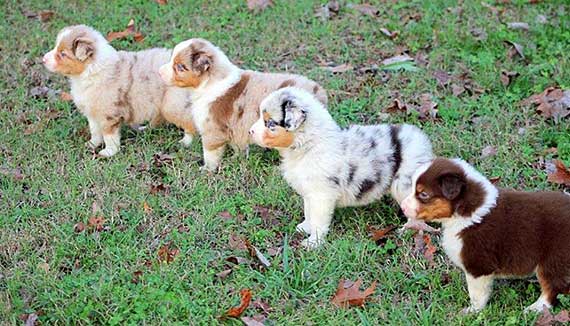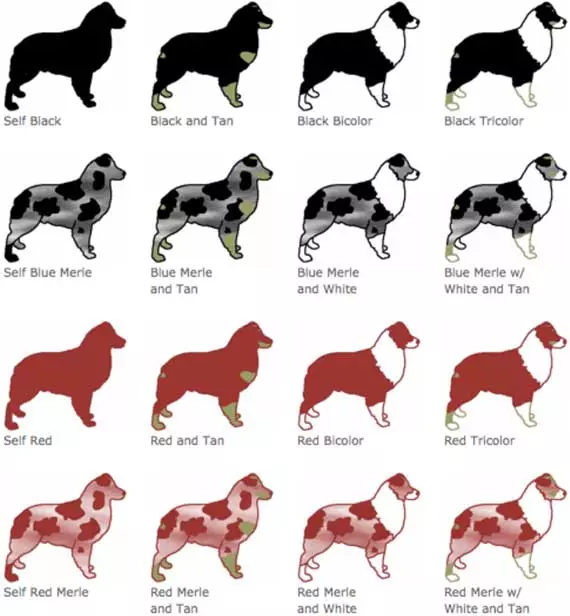
Australian Shepherd Colors and Markings
Color Gene Pair
Pattern Gene Pair
Tan Points and White Markings
Aussie 16 Basic Color Combinations Chart

Lee Greywolf Lopez
Aussie colors and markings come in an amazing variety of combinations but are really only made up of two gene pairs.
The first gene pair controls which colour an Aussie will be and they are either black or red.
The second gene pair controls the pattern and whether the coat will be solid or merle. We'll talk about this gene pair later, but first...
Australian Shepherd Color Gene Pair
In the gene pair that controls colour the black is dominant and is denoted by a B. The recessive red is denoted by a b.
This means that there are three possible combinations that an Australian Shepherd could inherit. They could be BB, Bb or bb.
When the inherited gene pairs are the same such as BB or bb this is referred to as homozygous as they have the same gene on each chromosome. In a case where Bb is inherited and we have a different gene on each chromosome it is called heterozygous.
So, a dog with BB has two genes that are dominant for black. They will be black and will only produce puppies that are also black. Since it only has dominant genes to give its puppies would all inherit the dominant B gene and would be black even if mated to a bb.
An Australian Shepherd with the Bb gene pair is a black dog but it carries the recessive b gene for the red color. These dogs are called red carriers or red factored. If bred with a BB this dog would produce puppies that were all black. Some of the puppies would be BB while some could be Bb and also carry the recessive red gene.
If a Bb were crossed with another Bb they could have BB (black), Bb (black) and bb (red) puppies. If bred with a bb (red) there could be either Bb (black) or bb (red) puppies born.
So, if a bb were crossed with another bb then only red bb puppies would result.
Once you see how this inheritance works its fairly easy to determine what the chances are of different colored puppies being born in a litter.
Australian Shepherd Pattern Gene Pair
Australian Shepherd coat patterns come in solid and merle. Merle is the mottled blend of the dog's color (black or red) to a near white or white.
Merle is the dominant gene while solid is recessive. Merle is represented by an M while solid is shown as m. As with the color gene pairs there are three possible pairings - MM, Mm and mm.
The homozygous MM combination is of particular concern. This pair comes as a result of breeding two Aussies with the merle pattern. This "double merle" combination is often referred to as "lethal white".
Having two merle genes results in puppies that have excessive white in their coats. This is much more serious than a cosmetic concern about appearance. The lack of pigment around the ears and eyes results in severe defects that can render the dog permanently deaf, blind or both. This is why you should not breed merles with merles.
For more information about "lethal white merles" read our in-depth article here.
If a dog with the MM gene pair were bred with a heterozygous merle Mm it would result in more MM homozygous merles as well as Mm heterozygous merles. However, because the merle gene is dominant they could never produce solid offspring.
In the case of a Mm heterozygous merle breeding with another Mm merle the puppies could be MM homozygous merles, Mm heterozygous merles or mm solid color.
Finally we have the mm solid dog. When crossed with a homozygous MM it would result in heterozygous merles Mm only. Breeding with a heterozygous Mm merle would produce merle Mm and solid mm puppies. If crossed with another solid mm dog only solid mm puppies would result.
Australian Shepherd Tan Points and White Markings
Common to the Australian Shepherd are tan points that appear in many variations from a rich copper to a lighter cream color. Tan points also cover a range of areas from the "shepherd's spots" above the eyes, the muzzle and cheeks as well as front legs, hind legs and feet.
In cases where the tan points are diminished the spot uder the tail can be an indicator that the dog has inherited tan markings. Sometimes this is the only location that the tan coloring is in evidence.
Puppies can be born will no tan markings except in that one spot under the tail and then develop them in other areas as time goes by. This spot may be the only way to tell if a bicolor is really a tricolor.
The Irish spotting gene influences white blazes, collars, legs and feet. Plus and minus modifiers act further to change the amount of white that appears. This can result in more white appearing than is acceptable under breed standards. Excessive white is grounds for disqualification from the conformation ring.
The Piebald gene is another gene that governs white areas and can be responsible for white spots or patches appearing on the body. Sometimes this modification is so extreme as to make the dog appear to be a homozygous merle.
In order to discourage breeding dogs with excessive white and the attendant health risks breed standards set limits on acceptable areas of white coverage. White collars that extend into the body beyond the withers and white patches on the body are to be avoided.
Australian Shepherd 16 Basic Color Combinations Chart
The following illustrated Austalian Shepherd coat color combinations chart shows you the basic 16 possibilities. These combinations are the most common accounting for colors (red or black), coat pattern (solid or merle) and the degree of tan points and white markings.

For further reading:
Color FAQ on ASHGI for the Australian Shepherd
Have Dog Training Questions?
Check out these introductory dog training videos...
I want my dog to stop being aggressive.
I want some help training my new puppy.
I want my dog to stop barking at everything.
Get Australian Shepherd Info, Website Updates, Special Offers, and Cartoons...
FREE GIFT
You'll also receive a free copy of the ebook
My Everyday Dog Training Tools
by professional dog trainer Daniel Abdelnoor, "Doggy Dan"











 Loading Image...
Loading Image...